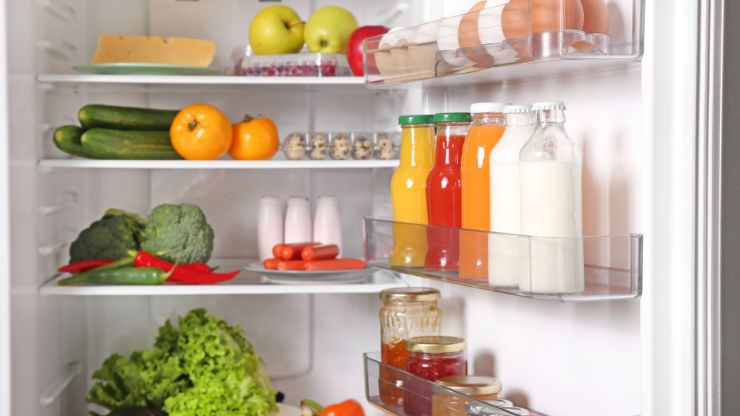Unlock the secrets of proper food storage as we delve into the essential guide on “15 Foods That Should Never Be Placed in the Refrigerator.” While the refrigerator is a staple appliance for preserving freshness, certain foods thrive better outside its chilly confines. Understanding which items fare better at room temperature can not only enhance flavor and texture but also extend shelf life.
Join us on this culinary exploration as we unveil the dos and don’ts of refrigeration, offering valuable insights into optimizing your kitchen storage practices. From the pantry to the countertop, discover the optimal placements for various foods to ensure your kitchen becomes a haven for freshness and vitality.
Foods Never Be Placed in the Refrigerator
1. Watermelon

Watermelon, with its juicy and vibrant flesh, is best kept out of the refrigerator. The cold temperatures can impede the natural ripening process and alter the texture and flavor of this refreshing fruit. Room temperature storage allows watermelon to retain its sweetness and optimal juiciness. Once cut, cover it and refrigerate only the portions you intend to consume within a day or two to preserve its freshness. So, keep your watermelon on the countertop for that perfect, sun-ripened taste, making it a delightful and hydrating treat on warm days.
2. Honey

Honey is a natural sweetener with remarkable preservative qualities, making refrigeration unnecessary. In fact, storing honey in the fridge can lead to crystallization, causing it to become thick and grainy. Honey’s low moisture content and acidic pH create an inhospitable environment for bacteria and spoilage. To maintain its liquid consistency and preserve its rich flavor, store honey in a cool, dry place at room temperature. A pantry or cupboard is an ideal spot, allowing you to enjoy the timeless sweetness of honey without the need for refrigeration.
For More- World’s Unhealthiest Canned Foods
3. Coffee

Coffee beans or ground coffee should be kept away from the refrigerator. Coffee is porous and can absorb odors and moisture, affecting its flavor. The cold, damp environment of the fridge can lead to the deterioration of coffee quality. Instead, store your coffee beans or grounds in an airtight container in a cool, dark place, such as a pantry. This preserves the freshness, aroma, and taste of your coffee, ensuring a delightful and robust cup every time. Remember, freshness is key to a satisfying coffee experience, and keeping it in a sealed container at room temperature is the way to go.
4. Pumpkin

Pumpkins, when whole and uncut, do best in a cool, dry place rather than in the refrigerator. The cold temperatures of the fridge can accelerate the breakdown of starches into sugars, altering the pumpkin’s texture and taste. Plus, refrigeration may lead to premature decay. Preserve the freshness of your pumpkin by storing it in a well-ventilated area with moderate temperatures, like a pantry or countertop.
Once cut, refrigerate unused portions wrapped in plastic or placed in an airtight container. This ensures your pumpkins stay deliciously flavorful, whether you’re crafting autumn dishes or preparing for festive decorations.
5. Onions

Onions are best stored in a cool, dry place with good ventilation rather than the refrigerator. Cold and humid conditions can lead to mold and sprouting, affecting the onion’s texture and flavor. Keep onions in a mesh bag or a basket, allowing air circulation to prevent moisture buildup. Avoid storing onions near potatoes, as the gases they release can cause each other to spoil faster.
Once an onion is cut, refrigerate the unused portion in a sealed container. By following these storage practices, you can enjoy the full flavor and freshness of onions in your culinary creations.
6. Nutella

Nutella, the delightful chocolate hazelnut spread, does not need refrigeration. In fact, keeping it in the fridge can cause the spread to harden, making it less spreadable and affecting its creamy texture. Nutella’s unique combination of ingredients, including sugar and oil, acts as a natural preservative. Store Nutella in a cool, dry place like your pantry or cupboard.
This ensures it remains smooth and ready to enhance your toast, pancakes, or desserts at a moment’s notice. Enjoy the rich and indulgent flavor of Nutella by keeping it at room temperature, readily available for your sweet cravings.
7. Olive Oil

Olive oil is best stored in a cool, dark place at room temperature, avoiding exposure to heat and light. While refrigeration may cause the oil to solidify, especially if it contains monounsaturated fats, this doesn’t harm its quality. However, storing olive oil in the fridge can make it thicker and less pourable. To preserve its flavor and nutritional benefits, keep your olive oil in a tightly sealed, dark glass bottle or stainless steel container in a cupboard or pantry. This ensures easy access to the liquid gold for cooking or drizzling over salads while maintaining its optimal taste and consistency.
8. Herbs

Fresh herbs, such as parsley, cilantro, and basil, should be stored differently than in the refrigerator. While it’s common to refrigerate them, this may cause them to wilt and lose flavor quickly. Instead, place fresh herbs like flowers in a jar with water on the countertop. This mimics their natural environment and keeps them fresh for a more extended period.
For hardier herbs like rosemary or thyme, refrigeration is suitable but store them in a partially damp paper towel in a sealed bag. Proper herb storage ensures that their flavors and aromas enhance your dishes, providing a burst of freshness to your culinary creations.
9. Tomatoes

Tomatoes, ideally, should not be stored in the refrigerator. Cold temperatures can negatively impact their flavor and texture, causing them to lose their natural sweetness and become mealy. Instead, store tomatoes at room temperature on the countertop, away from direct sunlight. To maximize freshness, keep them stem-side down, preventing moisture and air from entering the tomato.
Once fully ripened, if you need to slow down the ripening process, you can transfer them to the refrigerator. However, bring them back to room temperature before consuming to restore their optimal taste and texture. Following these storage tips ensures that your tomatoes are flavorful and ready to enhance your salads, sandwiches, and various dishes.
10. Ketchup

Ketchup, a staple condiment, doesn’t require refrigeration due to its vinegar and high sugar content, acting as natural preservatives. While refrigeration won’t harm ketchup, storing it in the pantry is common and maintains its quality. However, for optimal taste and texture, it’s crucial to keep the cap tightly closed to prevent air exposure. This ensures your ketchup remains fresh and ready to add a burst of tangy flavor to your favorite dishes without the need for refrigeration. So, keep your ketchup in the pantry, easily accessible for all your dipping and drizzling needs.
11. Tuna

Canned tuna is a pantry-friendly staple that doesn’t require refrigeration until opened. The canning process preserves the tuna, making it safe to store at room temperature. Once opened, refrigerate any unused portions in a sealed container. On the other hand, vacuum-sealed or pouched tuna that doesn’t require refrigeration until opened is convenient for on-the-go meals.
Always check the packaging for specific storage instructions, but generally, canned and packaged tuna can be efficiently stored in the pantry until ready for use. This ensures you have a versatile and quick protein source readily available for salads, sandwiches, or various recipes.
12. Bread

Bread is best stored at room temperature in a cool, dry place rather than in the refrigerator. Refrigeration can accelerate the staling process, causing the bread to become dry and lose its softness. Instead, keep bread in a breadbox, on the countertop, or in a pantry. To extend its freshness, consider freezing slices you won’t use within a few days.
Wrap the bread tightly in plastic or aluminum foil before freezing, and then thaw slices as needed. This ensures you enjoy the full flavor and texture of your bread, whether you’re making sandwiches, toasting slices, or using them for various recipes.
13. Potatoes

Potatoes should be stored in a cool, dark place with good ventilation, avoiding the refrigerator. Cold temperatures can cause the starches in potatoes to convert into sugars, affecting their taste and texture. A pantry or a cellar is an ideal spot for storing potatoes. Keep them in a paper or mesh bag to ensure proper airflow.
Additionally, store potatoes away from onions, as both release gases that can lead to quicker spoilage. Checking for any sprouting or signs of decay regularly is recommended. Following these storage guidelines helps maintain the quality and flavor of your potatoes, ensuring they’re ready for various culinary creations.
14. Apples

Apples are best stored in the refrigerator to maintain their freshness and crispness. The cold temperature helps slow down the ripening process and preserves their texture and flavor. Place them in the crisper drawer, away from other fruits and vegetables, as apples emit ethylene gas, which can accelerate the ripening of nearby produce.
Before refrigerating, ensure the apples are dry, as moisture can lead to mold growth. If you prefer apples at room temperature, store a small quantity in a fruit bowl and replenish as needed. Refrigerating the majority of your apples extends their shelf life, allowing you to enjoy these crunchy and nutritious fruits for a more extended period.
15. Avocadoes

Avocados should be stored at room temperature until they are ripe, after which they can be moved to the refrigerator. If your avocados are still firm and need to ripen, leave them on the countertop. Once they reach the desired ripeness, storing them in the refrigerator can help slow down the process and extend their shelf life.
However, it’s essential not to refrigerate unripe avocados, as the cold temperatures can hinder their ripening. Once cut, store any unused portions in an airtight container in the refrigerator, ensuring they stay fresh and ready for your next meal. Regularly check their ripeness to enjoy the creamy texture and rich flavor of perfectly ripe avocados.
Also Read- 7 Breathtaking Fast-Food Restaurants That Dazzle
Conclusion
Understanding the proper storage for various foods is essential for preserving their quality, taste, and nutritional value. While refrigeration is necessary for some items, it’s crucial to recognize that not all foods thrive in colder environments. From preserving the texture of bread to enhancing the flavor of tomatoes, proper storage practices ensure your kitchen remains a hub of fresh and delicious ingredients.
FAQs
Tomatoes lose their natural sweetness and become mealy in the refrigerator. Storing them at room temperature maintains their optimal flavor and texture.
Avocados should be stored at room temperature until ripe. Once ripe, move them to the refrigerator to slow down the ripening process.
No, potatoes should be stored in a cool, dark place with good ventilation. Refrigeration can lead to the conversion of starches into sugars, affecting taste.







